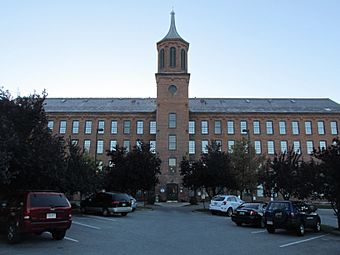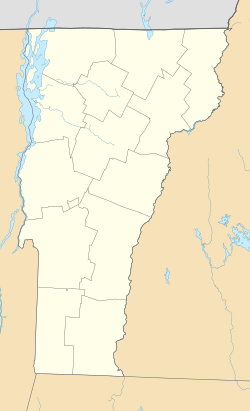Holden–Leonard Mill Complex facts for kids
Quick facts for kids |
|
|
Holden–Leonard Mill Complex
|
|
 |
|
| Location | 160 Benmont Ave., Bennington, Vermont |
|---|---|
| Area | 14 acres (5.7 ha) |
| Built | 1865 |
| NRHP reference No. | 88002085 |
| Added to NRHP | November 14, 1988 |
The Holden–Leonard Mill Complex, often called the Big Mill, is a very old and important group of buildings in Bennington, Vermont. It was built between 1865 and 1925. This mill was one of the biggest and most interesting factories in Vermont during the 1800s. It gave many people jobs for a long time. Today, the buildings are used for different businesses. It was added to the National Register of Historic Places in 1988 because of its history.
Discovering the Historic Big Mill
What the Mill Looks Like
The Holden–Leonard Mill is located in Bennington, near the Walloomsac River. It sits between Holden and Leonard Streets. The complex has 28 buildings. Many of these buildings are connected together.
The most important part is the "Big Mill" building, also known as Building 5. This was the main building when the mill started in 1865. It is a large brick building with 4-1/2 stories. It is about 227 feet wide and 53 feet deep. A tall, six-part tower sticks out from its middle. The tower has an eight-sided bell tower at the top. The basement of the building still has part of the original penstock. This was a pipe that controlled the water used to power the mill's machines.
A Look Back at the Mill's History
Bennington started making textiles (like cloth) on a large scale after the railroad arrived in the early 1850s. They began by making knitwear. The Big Mill was built in 1865 by Seth Hunt and Philip Tillinghast. They tried to make paisley women's shawls. However, these shawls were not very popular.
In 1875, the Bennington Woolen Company took over the building. They started making material for overcoats. Over time, under this company and others, the factory grew much larger. The mill grew the most after the First World War. During the war, the factory made a lot of cloth for the war effort.
By 1920, the Holden–Leonard Company was the biggest employer in the area. About 800 people worked there. The mill eventually closed because of the Great Depression. It was then used for about 10 years to make knit goods. Since then, the buildings have been used for many different smaller businesses.



